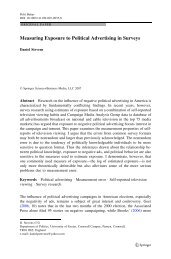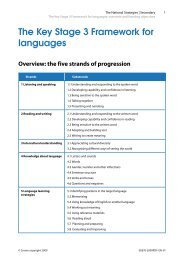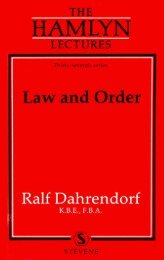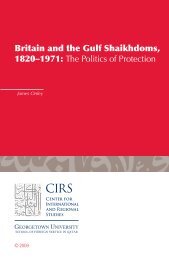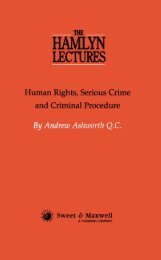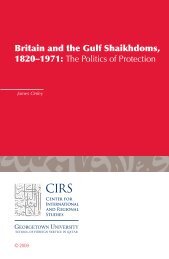Blackstone's Tower: The English Law School - College of Social ...
Blackstone's Tower: The English Law School - College of Social ...
Blackstone's Tower: The English Law School - College of Social ...
Create successful ePaper yourself
Turn your PDF publications into a flip-book with our unique Google optimized e-Paper software.
What are <strong>Law</strong> <strong>School</strong>s for?<br />
ibid. Chap. 3.<br />
see below, Chap. 4.<br />
Undergraduate intakes range quite widely. In 1991-92 the average intake for<br />
former polytechnics was 73, for "traditional" universities the average for middle<br />
range law schools was about 130-150, but the populations varied from over 700<br />
in Oxford and Cambridge to under 200 in City, SOAS, Lancaster, and Surrey. P.<br />
Harris and S. Bellerby, A Survey <strong>of</strong> <strong>Law</strong> Teaching 1993 at p. 36, Wilson, op.<br />
cit., at pp. 156-158.<br />
Jill Cottrell, "10 + 2 + 5; a Change in the Structure <strong>of</strong> Indian Legal Education",<br />
(1986) 36 J. Legal Educ. 331.<br />
C. Mallat, <strong>The</strong> revival <strong>of</strong> Islamic <strong>Law</strong> (1993) Chap. 1.<br />
R. Stevens, <strong>Law</strong> <strong>School</strong> (1983) at p. 8.<br />
On the history <strong>of</strong> accreditation <strong>of</strong> law schools by the American Bar Association<br />
see Susan K. Boyd, <strong>The</strong> ABA's First Section: Assuring a Qualified Bar (1993); for<br />
a more critical view, see Robert Stevens, <strong>Law</strong> <strong>School</strong> (1983), op. cit.<br />
e.g. Stephen Maher, "Clinical Legal Education in the Age <strong>of</strong> Unreason" (1992)<br />
40 Buffalo L. Rev. 809.<br />
Jerome Frank, Courts on Trial (1949) Chap. xvi. <strong>The</strong> most important attempt to<br />
apply Jerome Frank's ideas was Antioch <strong>Law</strong> <strong>School</strong>, which closed down in 1988;<br />
it was in due course was replaced by the District <strong>of</strong> Columbia <strong>School</strong> <strong>of</strong> <strong>Law</strong>,<br />
which was prepared to conform more to established orthodoxy. On Antioch see<br />
T. Anderson and R. Catz, "Towards a Comprehensive Approach to Clinical Education:<br />
A Response to the New Reality," (1981) 59 Washington U. L. Q. 727<br />
International Legal Center, Legal Education in a Changing World (1975) at p. 39.<br />
On NLSIU, Bangalore see (1989) Commonwealth Legal Education Association<br />
Newsletter, pp. 11-12.<br />
See further, William Twining, "Developments in Legal Education: Beyond the<br />
Primary <strong>School</strong> Model", (1990) 2 Legal Education Review 35.<br />
<strong>The</strong> Ormrod Committee originally recommended that "conversion" should take<br />
two years (paras. 112-115) but this was reduced to one year; for a critique <strong>of</strong><br />
the present situation see Peter Birks, "Short Cuts" in P. Birks (ed) Reviewing Legal<br />
Education (1994).<br />
Legal education was within the terms <strong>of</strong> reference <strong>of</strong> the Royal Commission on<br />
Legal Services (Benson Committee, reported 1979) and the Committee on the<br />
Future <strong>of</strong> the Legal Pr<strong>of</strong>ession (Marre Committee, reported 1988), but neither<br />
made much impact.<br />
<strong>The</strong> recent ACLEC Consultation Paper on <strong>The</strong> Initial stage (June, 1994) states that<br />
it has not ruled out any models, but sees lack <strong>of</strong> available resources hampering<br />
any substantial move away from the present structure (para. 1.19).<br />
By 1994 strong pressure had built up, mainly from the Society <strong>of</strong> Public Teachers<br />
<strong>of</strong> <strong>Law</strong>, to extend the period <strong>of</strong> "conversion" <strong>of</strong> non-law graduates to two years.<br />
Since many universities already provided for an accelerated law degree for graduates<br />
this could have the effect <strong>of</strong> the universities acquiring a virtual monopoly<br />
over the initial or academic stage <strong>of</strong> pr<strong>of</strong>essional formation. However, even if<br />
conversion were made more rigorous, it would not necessarily be the case that<br />
the non-law graduate route would be effectively closed <strong>of</strong>f, for conversion<br />
courses could be <strong>of</strong>fered by non-university institutions or conversion might not<br />
involve any formal instruction. See generally the papers by Peter Birks and Robert<br />
Stevens in Reviewing Legal Education (1994), op. cit. at n. 23. <strong>The</strong> Advisory<br />
Committee in its consultation paper on <strong>The</strong> Initial stage was unequivocal about<br />
the survival <strong>of</strong> the non-law graduate route: "Nevertheless, the law degree route<br />
cannot be the only one." op. cit. n. 25 at para. 4.27.<br />
62







